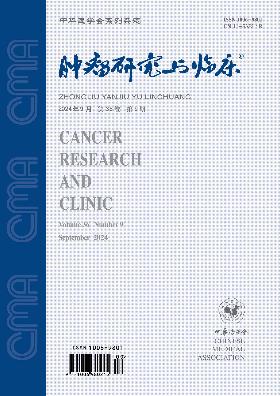A clinical analysis of esophageal cancer patients in different nutritional status treated with radiotherapy
Q4 Medicine
引用次数: 0
Abstract
目的 探讨不同营养状况食管癌放疗患者体力状况、生命质量及疗效。 方法 回顾性分析2017年12月至2018年12月山西省肿瘤医院收治的食管鳞状细胞癌患者62例,根据患者产生的主观整体评估量表分为营养状况良好组(A组)18例、轻中度营养不良组(B组)25例、重度营养不良组(C组)19例。所有患者均接受局部根治性放疗。比较各组患者放疗前后体力状况、生命质量、近期疗效及放射性食管炎发生情况。 结果 A组放疗结束时及放疗结束3个月Karnofsky评分及生命质量评分均优于B组及C组(均P<0.05)。各组患者放疗结束时生命质量评分均较放疗前降低,放疗结束3个月较放疗结束时及放疗前升高。A组近期有效率为94.4%(17/18),B组为92.0%(23/25),C组为89.5%(17/19),三组差异无统计学意义(χ2=0.778,P=1.000)。A组2~3级放射性食管炎发生率为22.2%(4/18),B组为24.0%(6/25),C组为68.4%(13/19),三组差异有统计学意义(χ2=11.534,P=0.003)。 结论 营养状况与患者体力状况、生命质量及放射性食管炎发生程度相关,营养状况良好可提高患者对治疗的耐受性。癌症食管癌不同营养状态放疗的临床分析
Objective: To explore the physical condition, quality of life, and efficacy of esophageal cancer radiotherapy patients with different nutritional status. Method: A retrospective analysis was conducted on 62 patients with esophageal squamous cell carcinoma admitted to Shanxi Cancer Hospital from December 2017 to December 2018. According to the subjective overall evaluation scale developed by the patients, they were divided into a group with good nutritional status (Group A) of 18 cases, a group with mild to moderate malnutrition (Group B) of 25 cases, and a group with severe malnutrition (Group C) of 19 cases. All patients received local radical radiotherapy. Compare the physical condition, quality of life, recent efficacy, and incidence of radiation esophagitis among patients in each group before and after radiotherapy. The Karnofsky score and quality of life score at the end of radiotherapy and 3 months after radiotherapy in Group A were better than those in Group B and Group C (both P<0.05). The quality of life scores of patients in each group decreased at the end of radiotherapy compared to before, and increased three months after radiotherapy compared to before and after radiotherapy. The recent effective rate in Group A was 94.4% (17/18), Group B was 92.0% (23/25), and Group C was 89.5% (17/19). There was no statistically significant difference among the three groups( χ 2=0.778, P=1.00). The incidence of grade 2-3 radiation esophagitis in Group A was 22.2% (4/18), Group B was 24.0% (6/25), and Group C was 68.4% (13/19), with statistically significant differences among the three groups( χ 2=11.534, P=0.003). Conclusion: Nutritional status is related to the patient's physical condition, quality of life, and degree of radiation esophagitis. Good nutritional status can improve the patient's tolerance to treatment.
本文章由计算机程序翻译,如有差异,请以英文原文为准。
求助全文
约1分钟内获得全文
求助全文
来源期刊

肿瘤研究与临床
Medicine-Oncology
CiteScore
0.10
自引率
0.00%
发文量
7737
期刊介绍:
"Cancer Research and Clinic" is a series of magazines of the Chinese Medical Association under the supervision of the National Health Commission and sponsored by the Chinese Medical Association.
It mainly reflects scientific research results and academic trends in the field of malignant tumors. The main columns include monographs, guidelines and consensus, standards and norms, treatises, short treatises, survey reports, reviews, clinical pathology (case) discussions, case reports, etc. The readers are middle- and senior-level medical staff engaged in basic research and clinical work on malignant tumors.
 求助内容:
求助内容: 应助结果提醒方式:
应助结果提醒方式:


